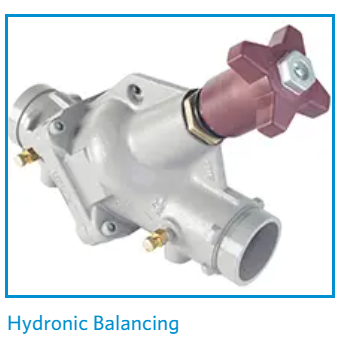Where do Circuit Balancing Valves (CBVs) fit in a hydronic system?
CBVs should be included in every branch of a hydronic system. For many applications such as boilers, chillers and heat pumps, they are needed to ensure balanced or equalized flow of water to all parts of a building and, as required by heating or cooling loads, across all branches of a system.
What is their purpose and how are they valuable?
Pressure drops in hydronic systems vary across a system. Points closer to a pump are at higher pressure differential compared to those further out. This differential leads to inefficiencies in a hydronic system, as branches may not receive the required flow and will experience inadequate heating or cooling. Hydronic balancing uses CBVs to solve this problem by regulating the flow and balancing the flow across all branches.
What are the key features to look for in a circuit balancing valve?
The most important feature for a CBV is accuracy and control of flow. A valve with millimeter level granularity can help achieve this target. Because CBVs balance pressure drops across loads to ensure adequate flow to all branches, an essential feature is adjustability, i.e., the ability to control the fluid flow rate reliably.
The second most important feature is a handle design that provides an accurate indication of the valve’s position and setting. In many installations balancing valves are used as isolation devices during maintenance. In these applications it’s critical for valve positions to be recorded to be able to return it to the original setting. Most “quarter turn” valves do not offer enough flow control accuracy, and typically do not include indicators of valve settings.
A third important feature for balancing valves is installation flexibility. Some valves do not function well when installed at different angles. A good design permits installations at any angle, to offer pipe design flexibility and convenient access for maintenance.
Lastly, for installations in tight spaces such as cabinets, a non-rising handle is also a valuable feature.
If you have additional questions on Circuit Balancing Valves, please contact us at
info@Armstrongfluidtechnology.com
|
|
Learn more about hydronic balancingAre balancing valves necessary in today’s variable-speed, variable-flow world. The short answer is yes, but what does balancing really mean and how is it accomplished? Watch this webinar to find out more.
|





